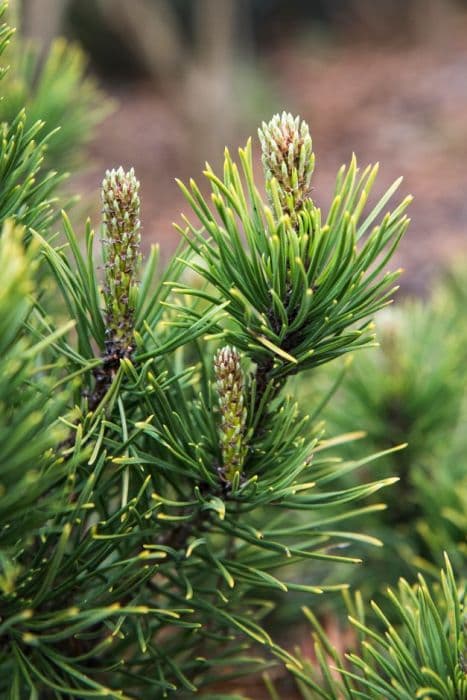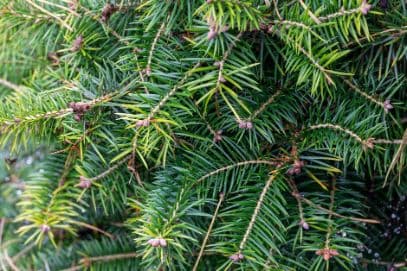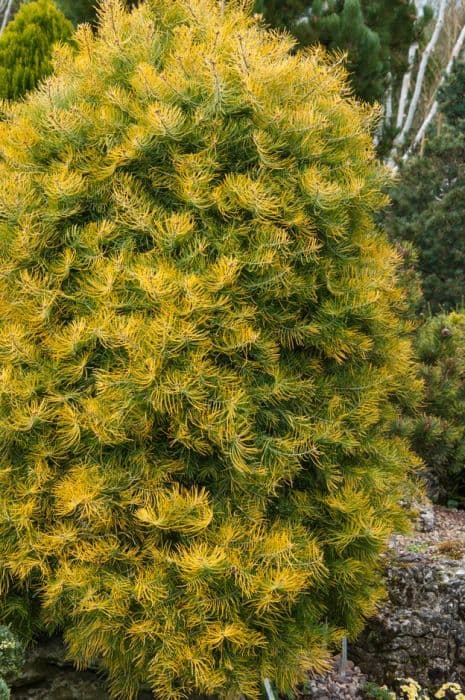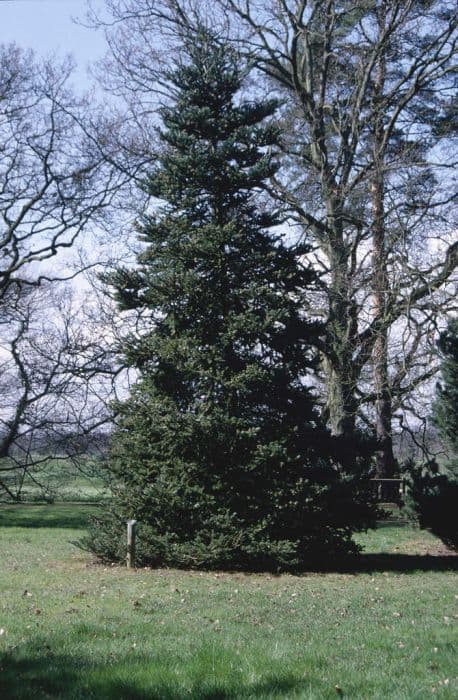Mugo Pine Pinus mugo 'Winter Gold'

ABOUT
The Mugo Pine 'Winter Gold' is a visually striking evergreen conifer known for its distinctive coloration and dense, bushy growth habit. Its needle-like leaves are arranged in pairs and have a deep green color throughout the growing season. As the common name suggests, 'Winter Gold' notably transforms as the weather cools, with its foliage taking on a golden-yellow hue that provides a warm contrast to often bleak winter landscapes. The needles are relatively short compared to those of other pine species, creating a somewhat fine texture that can appear almost fluffy from a distance. This change in color is more pronounced in the colder months, reverting to green as the temperatures rise. The overall shape of the plant is rounded and mound-like, with a tendency to grow in a slightly irregular form, giving it a natural and rugged appearance. The Mugo Pine 'Winter Gold' also produces pine cones, but they are small and not particularly conspicuous against the dense foliage. These cones add further interest to the plant, providing a textural contrast to the softness of the needles. Overall, the 'Winter Gold' is prized for its vibrant color, especially in winter, and its lush, coniferous texture. It's a favorite among gardeners looking to add year-round interest and color to their landscapes.
About this plant
 Names
NamesFamily
Pinaceae
Synonyms
Winter Gold Pine, Dwarf Mountain Pine, Mugo Pine, Mountain Pine
Common names
Pinus mugo 'Winter Gold'.
 Toxicity
ToxicityTo humans
The plant commonly known as mugo pine generally is not toxic to humans. There are no widespread reports of poisoning from ingesting parts of the mugo pine. However, consuming non-food plants is generally not advisable, and individual allergic reactions or sensitivities can occur.
To pets
The mugo pine is generally considered non-toxic to pets. Dogs and cats are unlikely to suffer poisoning from ingesting parts of this plant. As with any non-food plant, ingestion can potentially cause mild stomach upset, but significant toxic effects are not typically associated with the mugo pine.
 Characteristics
CharacteristicsLife cycle
Perennials
Foliage type
Evergreen
Color of leaves
Green
Height
3-5 feet (0.9-1.5 meters)
Spread
3-5 feet (0.9-1.5 meters)
Plant type
Shrub
Hardiness zones
2-8
Native area
Europe
Benefits
 General Benefits
General Benefits- Year-round interest: Pinus mugo 'Winter Gold', also known as mountain pine, offers visual appeal throughout the seasons with its evergreen needles and distinctive winter color.
- Low maintenance: Once established, mountain pine requires minimal care, making it an ideal plant for gardeners of all skill levels.
- Drought tolerance: This plant is well-suited for xeriscaping and can thrive in conditions with low water availability once established.
- Cold hardy: Mountain pine is capable of withstanding cold temperatures, making it suitable for planting in many temperate climates.
- Attracts wildlife: It can provide shelter and food for birds and other wildlife, enhancing the biodiversity of the garden.
- Soil stabilization: Mountain pine's root system can help prevent soil erosion, particularly in sloped areas.
- Adaptable to various soils: It can grow in a range of soil types, from sandy to clay, as long as the site is well-drained.
- Architectural interest: The unique shape and texture of mountain pine make it a striking addition to landscape designs.
- Compact size: Its relatively small stature makes it suitable for gardens with limited space or for use in containers.
- Seasonal color change: The needles of 'Winter Gold' take on a golden hue in winter, adding warmth to the garden palette during the colder months.
 Medical Properties
Medical PropertiesThis plant is not used for medical purposes.
 Air-purifying Qualities
Air-purifying QualitiesThis plant is not specifically known for air purifying qualities.
 Other Uses
Other Uses- Photography: Pinus mugo 'Winter Gold', commonly known as dwarf mountain pine, provides a vibrant splash of color in winter landscapes, making it a sought-after subject for photographers, especially when contrasted against snow.
- Model making: Due to its small size and unique texture, the dwarf mountain pine can be used in model railway setups or dioramas to replicate real-life landscapes on a miniature scale.
- Christmas decoration: During the festive season, dwarf mountain pine can be potted and used as a miniature Christmas tree, especially in small apartments or spaces.
- Artistic inspiration: Artists may use the distinct form and coloration of dwarf mountain pine as a motif or inspiration for paintings, sculptures, or other artistic creations.
- Floral arrangements: Its sturdy branches and dense foliage make the dwarf mountain pine suitable for inclusion in winter floral arrangements and wreathes, where it can add texture and a natural element.
- Hobby crafts: The cones and wood of dwarf mountain pine can be harvested and used in a variety of crafts, such as making pinecone ornaments or small wooden carvings.
- Educational use: Dwarf mountain pine can be used in schools or educational programs to teach about the different types of coniferous plants and their adaptations to winter conditions.
- Bonsai cultivation: Dwarf mountain pine can be cultivated as a bonsai, making it a popular choice for enthusiasts looking to add an evergreen species to their collection.
- Festivals and events: It can be displayed in botanical gardens and plant shows, especially in the winter season, to showcase its unique golden winter color.
- Nature therapy: The practice of Shinrin-yoku, or forest bathing, which emphasizes spending time in natural environments for well-being, can incorporate dwarf mountain pine areas for their calming golden hues in the winter season.
Interesting Facts
 Feng Shui
Feng ShuiThe Mugo Pine is not used in Feng Shui practice.
 Zodiac Sign Compitability
Zodiac Sign CompitabilityThe Mugo Pine is not used in astrology practice.
 Plant Symbolism
Plant Symbolism- Resilience: The mountain pine, an evergreen plant, symbolizes durability and the ability to withstand challenging conditions, reflecting its natural habitat in mountainous regions where it endures cold and harsh environments.
- Longevity: Since pines are known for their long lifespan, they represent enduring existence, immortality, and the continuous passage of time.
- Wisdom: The mountain pine can be seen as a symbol of wisdom, stemming from its ancient presence in the natural world and its observation of the passage of time and history.
- Fertility: Pine trees sometimes represent fertility, possibly because of their abundant seed production and widespread presence in diverse ecosystems.
- Peace: Pine trees have been used to symbolize peace, often due to their tranquil appearance and the soothing atmosphere they can create within their environments.
- Vitality: With the 'Winter Gold' variety having striking golden needles during the colder months, it stands for vitality and the persistence of life, even in dormancy or adverse seasons.
 Water
WaterThe Mountain Pine or Mugho Pine should be watered deeply and infrequently to ensure a well-established root system. During the first growing season, water the plant once a week with approximately 2 gallons per session to help the roots grow. Once established, the Mountain Pine is drought-tolerant and will require less frequent watering, roughly once every two to four weeks depending on rainfall and soil conditions. During prolonged dry spells, increase watering slightly. It's better to err on the side of underwatering as Mugho Pines do not like waterlogged soil.
 Light
LightThe Mountain Pine thrives in full sunlight conditions, meaning it should receive at least 6 hours of direct sun each day. The best spot for this plant is an open area where it can enjoy uninterrupted sunlight throughout the day. Partial shade is acceptable, but the color and density of the needles are optimal when the plant has full sun exposure.
 Temperature
TemperatureMugho Pines are hardy and can tolerate a wide range of temperatures, making them suitable for many climates. They can survive in temperatures as low as -50°F and as high as 100°F. However, the ideal temperature range for the Mountain Pine is between 60°F and 70°F during the growing season. These pines are mountainous plants and can typically handle the cold better than extreme heat.
 Pruning
PruningPruning the Mountain Pine is generally done to maintain its shape and health. Prune in late winter or early spring before new growth begins. Remove any dead or diseased branches and thin out dense areas to increase air circulation. Pruning can also be done to control the size if necessary. Annual pruning is often sufficient for maintaining the desired shape and health of the tree.
 Cleaning
CleaningNot needed
 Soil
SoilMountain Pine requires well-drained soil with a pH of 5.5 to 6.5. An ideal soil mix consists of 1 part peat, 1 part pine bark, and 1 part sand or perlite to ensure good drainage and aeration.
 Repotting
RepottingMountain Pine, being a slow-growing conifer, does not require frequent repotting. Repot every 4-5 years, preferably during the spring before new growth begins.
 Humidity & Misting
Humidity & MistingMountain Pine is tolerant of a wide range of humidity levels and does well in outdoor conditions where it can tolerate the varying natural humidity.
 Suitable locations
Suitable locationsIndoor
Ensure bright light, cool temps, and air flow for Mountain Pine.
Outdoor
Plant in full sun, well-draining soil for Mountain Pine.
Hardiness zone
Mountain Pine is suited for 2-8 USDA.
 Life cycle
Life cycleThe Dwarf Mountain Pine 'Winter Gold' begins its life cycle as a seed, usually requiring stratification (a period of cold temperature) to break dormancy. Upon germination, it progresses to a seedling stage, developing a taproot and initial needles. As it enters the juvenile stage, it starts to develop a woody stem and characteristic pine needles, and its growth rate increases. The plant reaches maturity in several years, forming a dense, bushy habit, and it will start to produce cones—male cones release pollen while female cones develop into seed-bearing structures after pollination. As a conifer, it continues to grow and produce cones annually, with some seasonal color variation where new winter growth may display a golden hue against the older green needles. The pine can live for many decades if conditions are favorable, with growth slowing as it ages.
 Propogation
PropogationPropogation time
Late winter
The most popular method of propagation for the Pinus mugo 'Winter Gold', commonly known as Mountain Pine, is by seed. Seeds are typically sown in late winter to early spring, after a period of cold stratification that mimics natural winter conditions. This can be done by placing the seeds in a mix of moist sand and peat moss, and then refrigerating them at about 34 to 41 degrees Fahrenheit (1 to 5 degrees Celsius) for a period of 4 to 6 weeks. Once stratified, the seeds should be sown in a well-draining seed starting mix and kept at around 68 degrees Fahrenheit (20 degrees Celsius), which is suitable for germination. It is important to keep the substrate moderately moist but not waterlogged to prevent the seeds from rotting. After the seedlings have developed a couple of sets of true leaves, they could be carefully transplanted into individual pots to grow on before being planted out in their final position once they are large enough to handle the conditions outdoors.









